Petrogenesis and Tectonic Significance of Miocene Volcanic Rocks in the Ahlatlı–İspir–Erzurum Region, Türkiye
Abstract
1. Introduction
2. Geological Background
3. Geology of the Region
4. Analytical Methods
5. Results
5.1. Petrography
5.2. Whole-Rock Geochemistry
5.2.1. Major Elements
5.2.2. Minor and Trace Elements
5.3. Sr–Nd Isotope Geochemistry
6. Discussion
6.1. Petrogenesis and Source Characteristics
6.2. Tectonic Setting
7. Conclusions
Author Contributions
Funding
Data Availability Statement
Acknowledgments
Conflicts of Interest
References
- Harangi, S.; Seghedi, I.; Lukács, R. The Neogene–Quaternary Volcanism of The Carpathian–Pannonian Region: From Initial Plate Tectonic Models To Quantitative Petrogenetic Explanations. Geol. Soc. Lond. Spec. Publ. 2024, 554, 2041–4927. [Google Scholar] [CrossRef]
- Pe-Piper, G.; Piper, D.J.W. Miocene Magnesian Andesites and Dacites, Evia, Greece: Adakites Associated with Subducting Slab Detachment and Extension. Lithos 1994, 31, 125–140. [Google Scholar] [CrossRef]
- Gao, P.; Santosh, M.; Yang, C.-X.; Dong, Y.; Nakagawa, M. Arc volcanic suite from a Miocene subduction system in SW Japan: A geochemical and zircon U–Pb–Lu–Hf study. Lithos 2021, 398–399, 106251. [Google Scholar] [CrossRef]
- Okay, A.I.; Tüysüz, O. Tethyan Sutures of Northern Turkey. Geol. Soc. Lond. Spec. Publ. 1999, 156, 475–515. [Google Scholar] [CrossRef]
- Asan, K. Whole-Rock Elemental and Sr-Nd Isotope Geochemistry and Petrogenesis Of The Miocene Elmadağ Volcanic Complex, Central Anatolia (Ankara, Turkey). Geosciences 2020, 10, 348. [Google Scholar] [CrossRef]
- Şengör, A.M.C.; Yılmaz, Y. Tethyan Evolution of Turkey: A Plate Tectonic Approach. Tectonophysics 1981, 75, 181–241. [Google Scholar] [CrossRef]
- Keskin, M. Magma generation by slab steepening and breakoff beneath a subduction-accretion complex: An alternative model for collision-related volcanism in Eastern Anatolia, Turkey. Geophys. Res. Lett. 2003, 30, 8046. [Google Scholar] [CrossRef]
- Pearce, J.A.; Harris, N.B.W.; Tindle, A.G. Trace element discrimination diagrams for the tectonic interpretation of granitic rocks. J. Petrol. 1984, 25, 956–983. [Google Scholar] [CrossRef]
- Yılmaz, Y.; Tüysüz, O.; Yiğitbaş, E.; Genç, Ş.C.; Şengör, A.M.C. Geology and tectonic evolution of the Pontides. In Regional and Petroleum Geology of the Black Sea and Surrounding Region; Robinson, A.G., Ed.; American Association of Petroleum Geologists: Tulsa, OK, USA, 1997; Volume 68, pp. 183–226. [Google Scholar]
- Şengör, A.M.C.; Özeren, M.S.; Genç, T.; Zor, E. Eastern Anatolian high plateau as a mantle-supported, north-south shortened domal structure. Geophys. Res. Lett. 2003, 30, 8045. [Google Scholar] [CrossRef]
- Bustos, E.; Capra, L.; Arnosio, M.; Norini, G. Volcanic debris avalanche transport and emplacement at Chimpa volcano (Central Puna, Argentina): Insights from morphology, grain-size and clast surficial textures. J. Volcanol. Geotherm. Res. 2022, 432, 107671. [Google Scholar] [CrossRef]
- Pereira, M.L.; Zanon, V.; Fernandes, I.; Pappalardo, L.; Viveiros, F. Hydrothermal alteration and physical and mechanical properties of rocks in a volcanic environment: A review. Earth-Sci. Rev. 2024, 252, 104754. [Google Scholar] [CrossRef]
- Pearce, J.A. Geochemical fingerprinting of oceanic basalts with applications to ophiolite classification and the search for Archean oceanic crust. Lithos 2008, 100, 14–48. [Google Scholar] [CrossRef]
- Lu, L.; Zhang, Y.T.; Li, Z.F.; Zhang, K.J. Petrogenesis of the alkali basalt and trachy-andesite suite in the northern tarim basin, nw china: Implications for crust-mantle interactions controlled by the permian mantle plume. Gondwana Res. 2023, 119, 86–103. [Google Scholar] [CrossRef]
- Eyüboğlu, Y. Late Cretaceous High-K Volcanism In The Eastern Pontide Orogenic Belt: Implications For The Geodynamic Evolution of NE Turkey. Int. Geol. Rev. 2009, 52, 142–186. [Google Scholar] [CrossRef]
- Özdamar, Ş. Geochemistry and Geochronology of Late Mesozoic Volcanic Rocks In The Northern Part Of The Eastern Pontide Orogenic Belt (Ne Turkey): Implications For The Closure Of The Neo-Tethys Ocean. Lithos 2016, 248, 240–256. [Google Scholar] [CrossRef]
- Aydınçakır, E.; Yücel, C.; Kaygusuz, A.; Bilici, Ö.; Yilmazer, S.; Ruffet, G. Eocene Magmatism Related to Postcollisional Extension In The Eastern Pontides (Ne Türkiye): 40Ar-39Ar Geochronology, Geochemistry, and Whole-Rock Sr-Nd-Pb-Hf Isotopes. Turk. J. Earth Sci. 2024, 33, 4. [Google Scholar] [CrossRef]
- Vural, A.; Kaygusuz, A. Geochronology, Petrogenesis and Tectonic Importance of Eocene I-Type Magmatism in the Eastern Pontides, NE Turkey. Arab. J. Geosci. 2021, 14, 467. [Google Scholar] [CrossRef]
- Kaygusuz, A. K/Ar Ages And Geochemistry of The Collision Related Volcanic Rocks in The Ilica (Erzurum) Area, Eastern Turkey. Neues Jahrb. Für Mineral.—Abh. 2009, 186, 21–36. [Google Scholar]
- Kaygusuz, A.; Aslan, Z.; Aydınçakır, E.; Yücel, C.; Gücer, M.A.; Şen, C. Geochemical and Sr–Nd–Pb isotope characteristics of the Miocene to Pliocene volcanic rocks from the Kandilli (Erzurum) area, Eastern Anatolia (Turkey): Implications for magma evolution in extension-related origin. Lithos 2018, 296–299, 332–351. [Google Scholar] [CrossRef]
- Temizel, İ.; Arslan, M. Petrology And Geochemistry Of Tertiary Volcanic Rocks From The Ikizce (Ordu) Area, Ne Turkey: Implications For The Evolution Of The Eastern Pontide Paleo-Magmatic Arc. J. Asian Earth Sci. 2008, 31, 439–463. [Google Scholar] [CrossRef]
- Topuz, G.; Altherr, R.; Schwarz, W.H.; Siebel, W.; Satır, M.; Dokuz, A. Post-Collisional Plutonism with Adakite-Like Signatures: The Eocene Saraycik Granodiorite (Eastern Pontides, Turkey). Contrib. Mineral. Petrol. 2005, 150, 441–455. [Google Scholar] [CrossRef]
- Kaygusuz, A.; Arslan, M.; Siebel, W.; Şen, C. Geochemical And Sr-Nd Isotopic Characteristics Of Post-Collisional Calc-Alkaline Volcanics In The Eastern Pontides (Ne Turkey). Turk. J. Earth Sci. 2011, 20, 137–159. [Google Scholar] [CrossRef]
- Temizel, İ.; Arslan, M.; Ruffet, G.; Peucat, J.J. Petrochemistry, Geochronology and Sr–Nd Isotopic Systematics of the Tertiary Collisional and Post-Collisional Volcanic Rocks from the Ulubey (Ordu) Area, Eastern Pontide, Ne Turkey: Implications for Extension-Related Origin and Mantle Source Characteristics. Lithos 2012, 128, 126–147. [Google Scholar]
- Yücel, C.; Arslan, M.; Temizel, İ.; Abdioğlu Yazar, E.; Ruffet, G. Evolution of K-rich magmas derived from a net veined lithospheric mantle in an ongoing extensional setting: Geochronology and geochemistry of Eocene and Miocene volcanic rocks from Eastern Pontides (Turkey). Gondwana Res. 2017, 45, 65–86. [Google Scholar] [CrossRef]
- Arslan, M.; Temizel, İ. A Geochemical Perspective on The Genesis of Cenozoic Basic Volcanism In Northeastern Turkey: An Overview of Metasomatism And Heterogeneity of The Sub-Continental Lithospheric Mantle In A Post-Collisional Setting. Acta Geochim. 2024, 43, 489–506. [Google Scholar] [CrossRef]
- Li, C.-F.; Chu, Z.-Y.; Guo, J.-H.; Li, Y.-L.; Yang, Y.-H.; Li, X.-H. A rapid single column separation scheme for high-precision Sr–Nd–Pb isotopic analysis in geological samples using thermal ionization mass spectrometry. Anal. Methods 2015, 7, 4793–4802. [Google Scholar] [CrossRef]
- Jerram, D.A.; Martin, V.M. Understanding crystal populations and their significance through the magma plumbing system. Geol. Soc. Lond. Spec. Publ. 2008, 304, 133–148. [Google Scholar] [CrossRef]
- Winter, J.D. Principles of Igneous and Metamorphic Petrology, 2nd ed.; Pearson Education: Boston, MA, USA, 2010. [Google Scholar]
- Rollinson, H. Using Geochemical Data: Evaluation, Presentation, Interpretation; Routledge (Taylor & Francis Group): London, UK; New York, NY, USA, 2013; pp. 1–351. [Google Scholar]
- Le Bas, M.J.; Le Maitre, R.W.; Streckeisen, A.; Zanettin, B. A chemical classification of volcanic rocks based on the total alkali-silica diagram. J. Petrol. 1986, 27, 745–750. [Google Scholar] [CrossRef]
- Irvine, T.N.; Baragar, W.R.A. A Guide To The Chemical Classification of the Common Volcanic Rocks. Can. J. Earth Sci. 1971, 8, 523–548. [Google Scholar] [CrossRef]
- Sun, S.S.; McDonough, W.F. Chemical and isotopic systematics of oceanic basalts: Implications for mantle composition and processes. Geol. Soc. Lond. Spec. Publ. 1989, 42, 313–345. [Google Scholar] [CrossRef]
- Boynton, W.V. Chapter 3—Cosmochemistry of the Rare Earth Elements: Meteorite Studies. In Developments in Geochemistry; Elsevier: Amsterdam, The Netherlands, 1984; Volume 2, pp. 63–114. [Google Scholar]
- Ertürk, M.A.; Kara, H.; Sar, A.; Yılmaz, İ.; Aysal, N. Geochronology and Petrogenesis of the Early Miocene Felsic Dykes: New Evidence for Initiation of Post-Collisional Magmatism in the Sw Malatya-Eastern Anatolia (Turkey). Geol. Carp. 2023, 74, 245–260. [Google Scholar]
- Faure, G.; Mensing, T.M. Isotopes: Principles and Applications, 3rd ed.; John Wiley and Sons: Hoboken, NJ, USA, 2005; p. 897. [Google Scholar]
- Steiger, R.H.; Jäger, E. Subcommission on geochronology: Convention on the use of decay constants in geo- and cosmochronology. Earth Planet. Sci. Lett. 1977, 36, 359–362. [Google Scholar] [CrossRef]
- Lugmair, G.W.; Marti, K. Lunar initial 143Nd/144Nd: Differential evolution of the lunar crust and mantle. Earth Planet. Sci. Lett. 1978, 39, 349–357. [Google Scholar] [CrossRef]
- Smith, E.I.; Sánchez, A.; Walker, J.D.; Wang, K. Geochemistry of Mafic Magmas in the Hurricane Volcanic Field, Utah: Implications for Small- and Large-Scale Chemical Variability of the Lithospheric Mantle. J. Geol. 1999, 107, 433–448. [Google Scholar] [CrossRef]
- Lino, L.M.; Quiroz-Valle, F.R.; Vlach, S.R.F.; Janasi, V.A.; Quiroz-Valle, C.R.; Basei, M.Á.S. Decoding the interplay between magma thermodynamics and lithospheric thermal state as a possible explanation for the origin of the daly gap. Earth Planet. Sci. Lett. 2024, 648, 119090. [Google Scholar] [CrossRef]
- Brenan, J.M.; Shaw, H.F.; Ryerson, F.J.; Phinney, D.L. Mineral-aqueous fluid partitioning of trace elements at 900 °C and 2.0 GPa: Constraints on the trace element chemistry of mantle and deep crustal fluids. Geochim. Cosmochim. Acta 1995, 59, 3331–3350. [Google Scholar] [CrossRef]
- Atlas, Z.D.; Germa, A.; Boss, B.; Meireles, O.; Ward, A.; Ryan, J.G. Variable Element Enrichment Sources and Contributions to Volcanic Rocks Along the Lesser Antilles Island Arc. Front. Earth Sci. 2022, 10, 782179. [Google Scholar] [CrossRef]
- Abdel-Rahman, A.F.M.; Nassar, P.E. Cenozoic volcanism in the Middle East: Petrogenesis of alkali basalts from northern Lebanon. Geol. Mag. 2004, 141, 545–563. [Google Scholar] [CrossRef]
- Xia, L.; Li, X. Basalt geochemistry as a diagnostic indicator of tectonic setting. Gondwana Res. 2019, 65, 43–67. [Google Scholar] [CrossRef]
- Álvaro, J.J.; Pouclet, A.; Ezzouhairi, H.; Soulaimani, A.; Bouougri, E.H.; Gil Imaz, A.; Fekkak, A. Early Neoproterozoic Rift-Related Magmatism In The Anti-Atlas Margin Of The West African Craton, Morocco. Precambrian Res. 2014, 255, 433–442. [Google Scholar] [CrossRef]
- Özdamar, Ş.; Billor, M.Z.; Sarıkaya, O.; Şans, B.E.; Yıldız, T.D.; Esenli, F.; Zou, H.; Sherlock, S.; Gültekin, A.H. Petrogenesis of Miocene volcanism in the Central Anatolia: Geochemical, isotopic and geochronological evidence. J. Volcanol. Geotherm. Res. 2024, 450, 108086. [Google Scholar] [CrossRef]
- Özkul, C.; Temizel, İ.; Özburan, M.; Arslan, M.; Kibici, Y. Geochronology and geochemistry of the Miocene volcanics from the Kütahya area: Constraints for post-collisional magmatism in western Anatolia, Turkey. J. Afr. Earth Sci. 2022, 195, 104679. [Google Scholar] [CrossRef]
- Ulrych, J.; Krmíček, L.; Tomek, Č.; Lloyd, F.E.; Ladenberger, A.; Ackerman, L.; Balogh, K. Petrogenesis of Miocene alkaline volcanic suites from western Bohemia: Whole rock geochemistry and Sr–Nd–Pb isotopic signatures. Geochemistry 2016, 76, 77–93. [Google Scholar] [CrossRef]
- Lino, L.M.; Quiroz-Valle, F.R.; Basei, M.Á.S.; Vlach, S.R.F.; Hueck, M.; Willbold, M.; Citroni, S.B.; Lemos-Santos, D.V. Petrogenesis and tectonic significance of two bimodal volcanic stages from the Ediacaran Campo Alegre-Corupá Basin (Brazil): Record of metacratonization during the consolidation of Western Gondwana. Precambrian Res. 2023, 385, 106950. [Google Scholar] [CrossRef]
- Asan, K.; Kurt, H.; Gündüz, M.; Gençoğlu Korkmaz, G.; Morgan, G. Geology, geochronology and geochemistry of the Miocene Sulutas volcanic complex, Konya-Central Anatolia: Genesis of orogenic and anorogenic rock associations in an extensional geodynamic setting. Int. Geol. Rev. 2019, 63, 161–192. [Google Scholar] [CrossRef]
- Temizel, I.; Arslan, M.; Yazar, E.A.; Aslan, Z.; Kaygusuz, A.; Eraydın, T.B. Zircon Usingle bondPb geochronology and petrology of the tholeiitic gabbro from the Kovanlık (Giresun) area: Constraints for the Late Cretaceous bimodal arc magmatism in the Eastern Pontides Orogenic Belt, NE Turkey. Lithos 2022, 428–429, 106840. [Google Scholar] [CrossRef]
- Rogers, N.; Macdonald, R.; Fitton, J.G.; George, R.; Smith, M. Two mantle plumes beneath the East African rift system: Sr, Nd and Pb isotope evidence from Kenya Rift basalts. Earth Planet. Sci. Lett. 2000, 176, 387–400. [Google Scholar] [CrossRef]
- Keskin, M. Eastern Anatolia: A hotspot in a collision zone without a mantle plume. Geol. Soc. Am. Spec. Pap. 2007, 430, 693–722. [Google Scholar]
- Dilek, Y.; Altunkaynak, Ş. Cenozoic Crustal Evolution and Mantle Dynamics of Post-Collisional Magmatism in Western Anatolia. Int. Geol. Rev. 2009, 49, 431–453. [Google Scholar] [CrossRef]
- Çubukçu, H.E.; Aydar, E.; Akın, L.; Şen, E. Temporal constraints on magmatic evolution of Acıgöl Bimodal Volcanic Field (Nevşehir, Türkiye). Geochemistry 2024, 84, 126129. [Google Scholar] [CrossRef]
- Gençalioğlu Kuşcu, G.; Geneli, F. Review of post-collisional volcanism in the Central Anatolian Volcanic Province (Turkey), with special reference to the Tepekoy Volcanic Complex. Int. J. Earth Sci. 2010, 99, 593–621. [Google Scholar] [CrossRef]
- Göçmengil, G.; Karacık, Z.; Genç, Ş.C.; Billor, M.Z. 40Ar–39Ar geochronology and petrogenesis of postcollisional trachytic volcanism along the İzmir–Ankara–Erzincan Suture Zone (NE Turkey). Turk. J. Earth Sci. 2018, 27, 1–31. [Google Scholar] [CrossRef]
- Aldanmaz, E.; Pearce, J.A.; Thirlwall, M.F.; Mitchell, J.G. Petrogenetic evolution of late Cenozoic, post-collision volcanism in western Anatolia, Turkey. J. Volcanol. Geotherm. Res. 2000, 102, 67–95. [Google Scholar] [CrossRef]
- Innocenti, F.; Agostini, S.; Di Vincenzo, G.; Doglioni, C.; Manetti, P.; Savaşçın, M.Y.; Tonarini, S. Neogene and Quaternary volcanism in Western Anatolia: Magma sources and geodynamic evolution. Mar. Geol. 2005, 221, 397–421. [Google Scholar] [CrossRef]
- Ersoy, E.Y.; Palmer, M.R.; Genç, Ş.C.; Prelević, D.; Akal, C.; Uysal, İ. Chemo-Probe into the Mantle Origin of the Nw Anatolia Eocene to Miocene Volcanic Rocks: Implications for The Role of Crustal Accretion, Subduction, Slab Roll-Back and Slab Break-Off Processes in Genesis of Post-Collisional Magmatism. Lithos 2017, 288–289, 55–71. [Google Scholar] [CrossRef]
- Uzel, B.; Kuiper, K.; Sözbilir, H.; Kaymakcı, N.; Langereis, C.G.; Boehm, K. Miocene geochronology and stratigraphy of western Anatolia: Insights from new Ar/Ar dataset. Lithos 2020, 352–353, 105305. [Google Scholar] [CrossRef]
- Aktağ, A.; Öztüfekçi Önal, A.; Sayit, K. Geochemistry of the post-collisional Miocene mafic Tunceli Volcanics, Eastern Turkey: Implications for the nature of the mantle source and melting systematics. Geochemistry 2019, 79, 123–129. [Google Scholar] [CrossRef]
- Eyüboğlu, Y.; Dilek, Y.; Bozkurt, E.; Bektas, O.; Rojay, B.; Sen, C. Structure and Geochemistry of an Alaskan-Type Ultramafic–Mafic Complex in the Eastern Pontides, NE Turkey. Gondwana Res. 2010, 18, 230–252. [Google Scholar] [CrossRef]
- Kaygusuz, A.; Yücel, C.; Arslan, M.; Temizel, I.; Yi, K.; Jeong, Y.-J.; Siebel, W.; Sipahi, F. Eocene I-Type Magmatism in the Eastern Pontides, Ne Turkey: Insights into Magma Genesis and Magma-Tectonic Evolution from Whole-Rock Geochemistry, Geochronology, and Isotope Systematics. Int. Geol. Rev. 2019, 62, 1406–1432. [Google Scholar] [CrossRef]
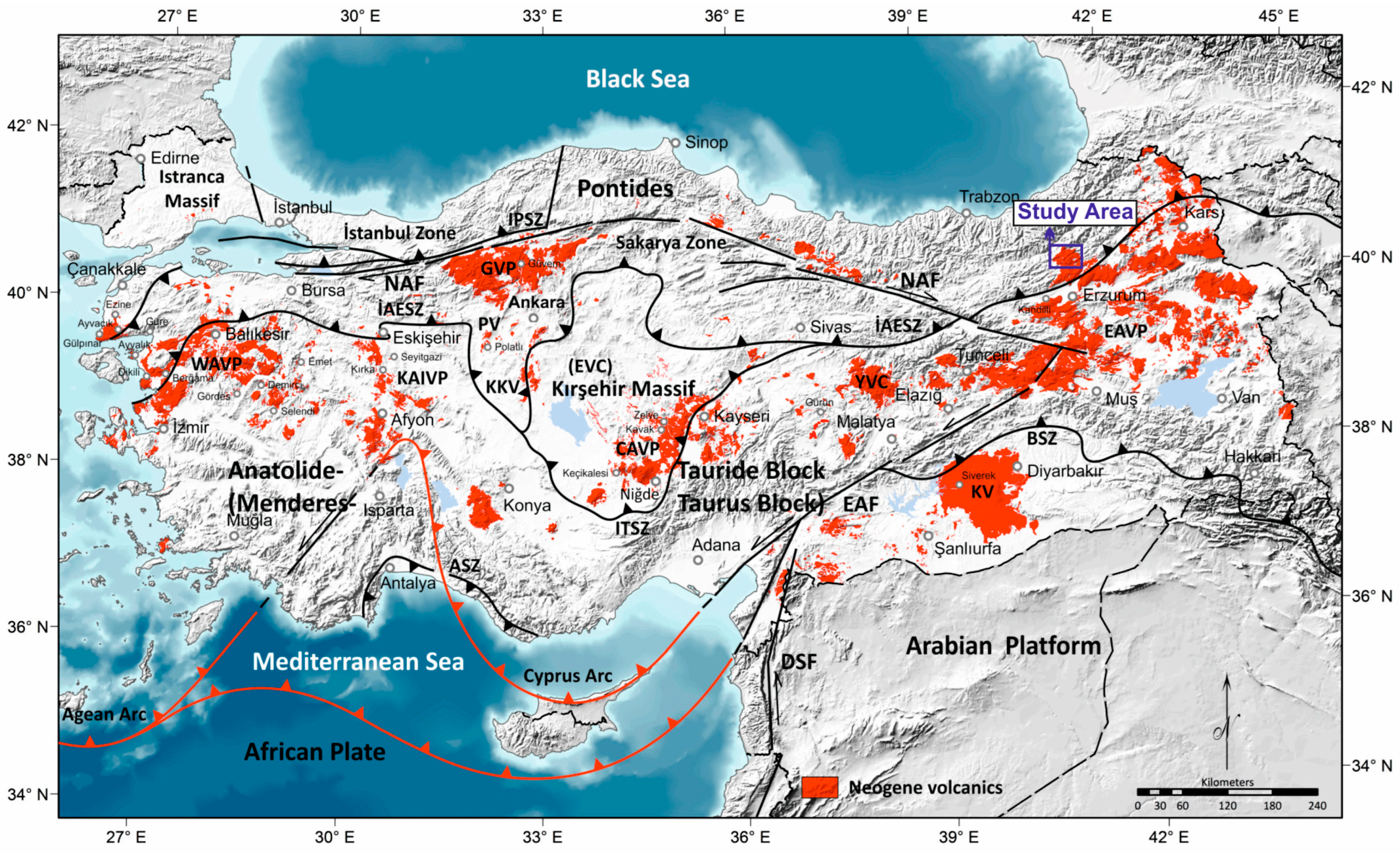
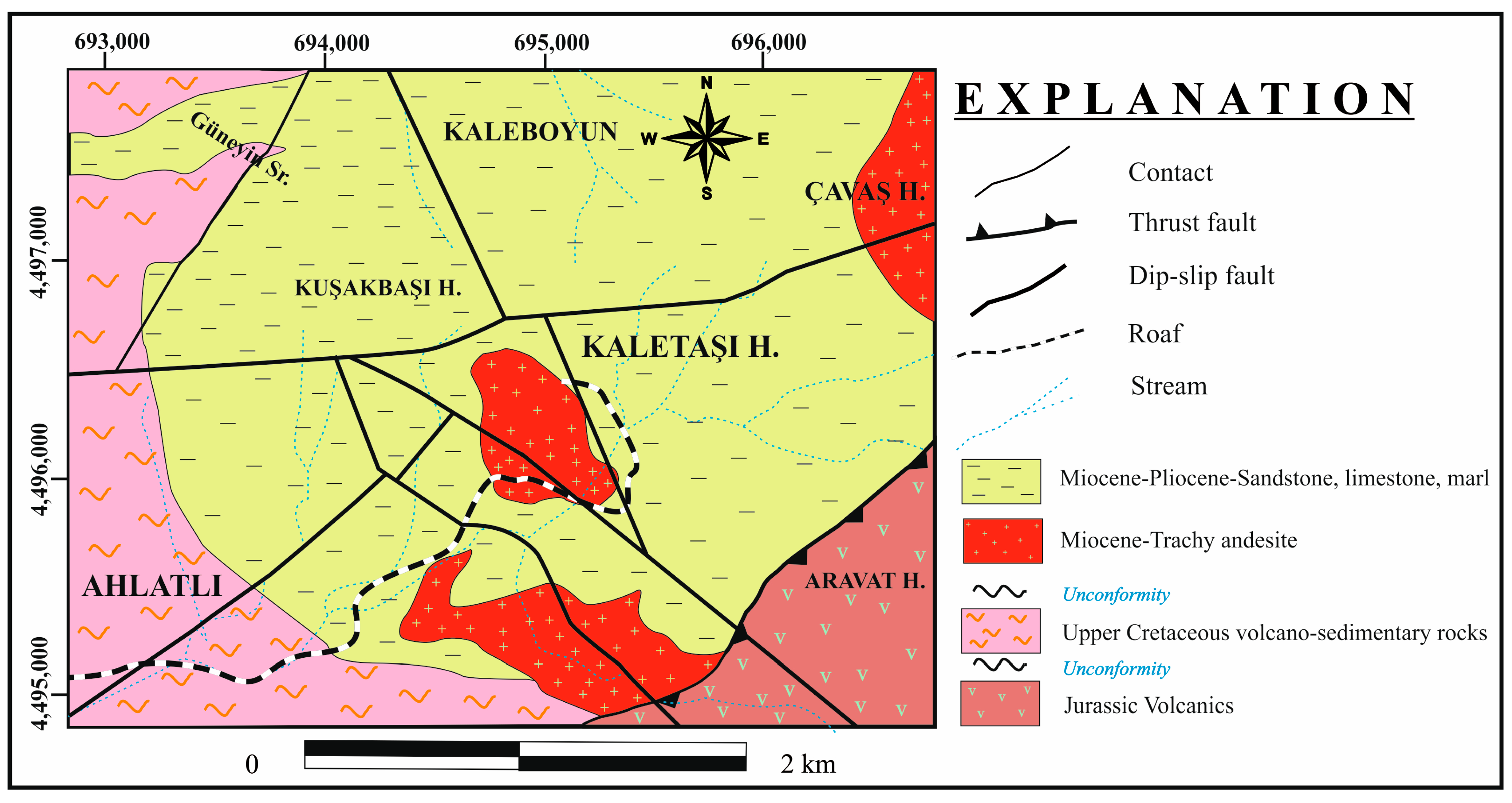
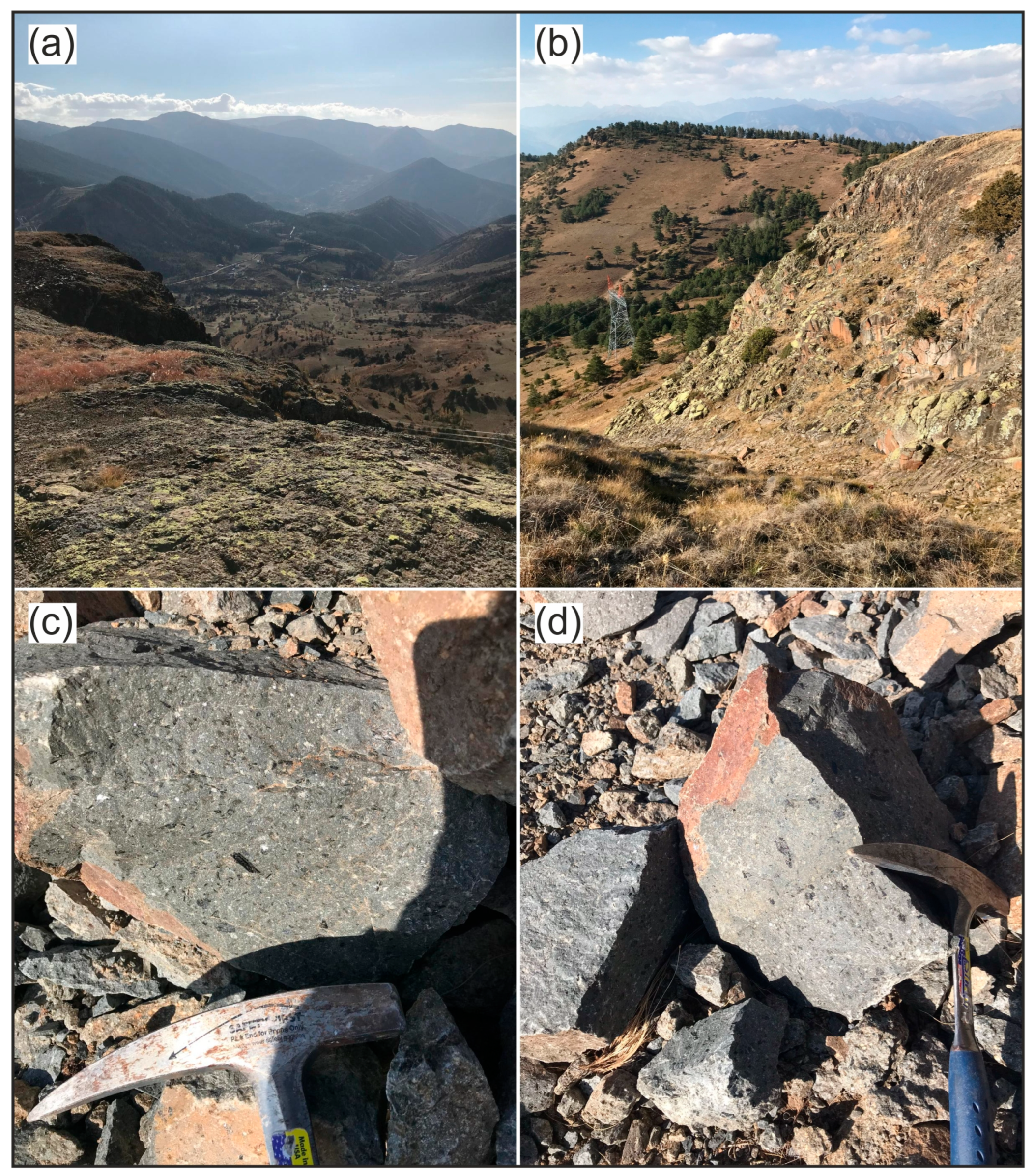
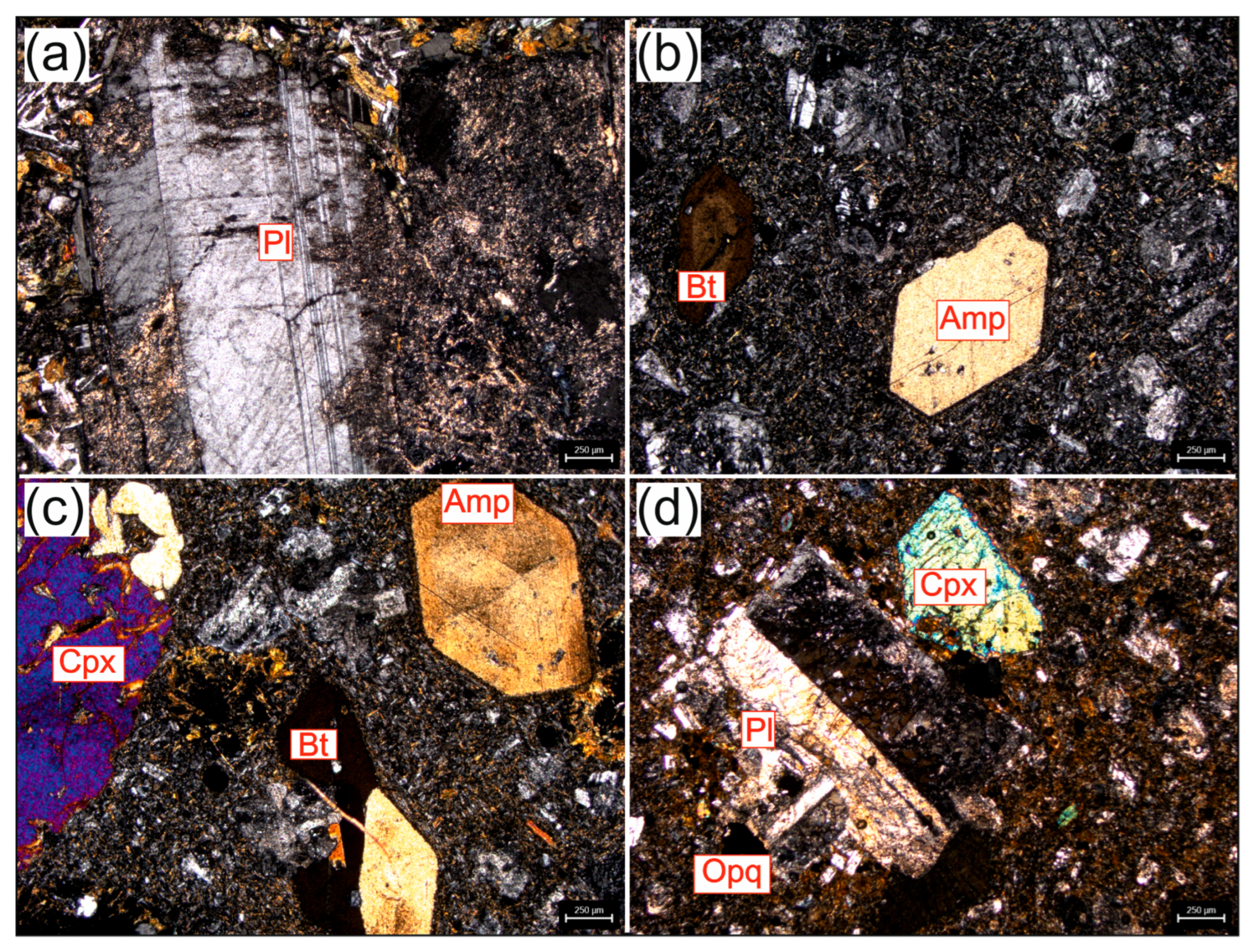
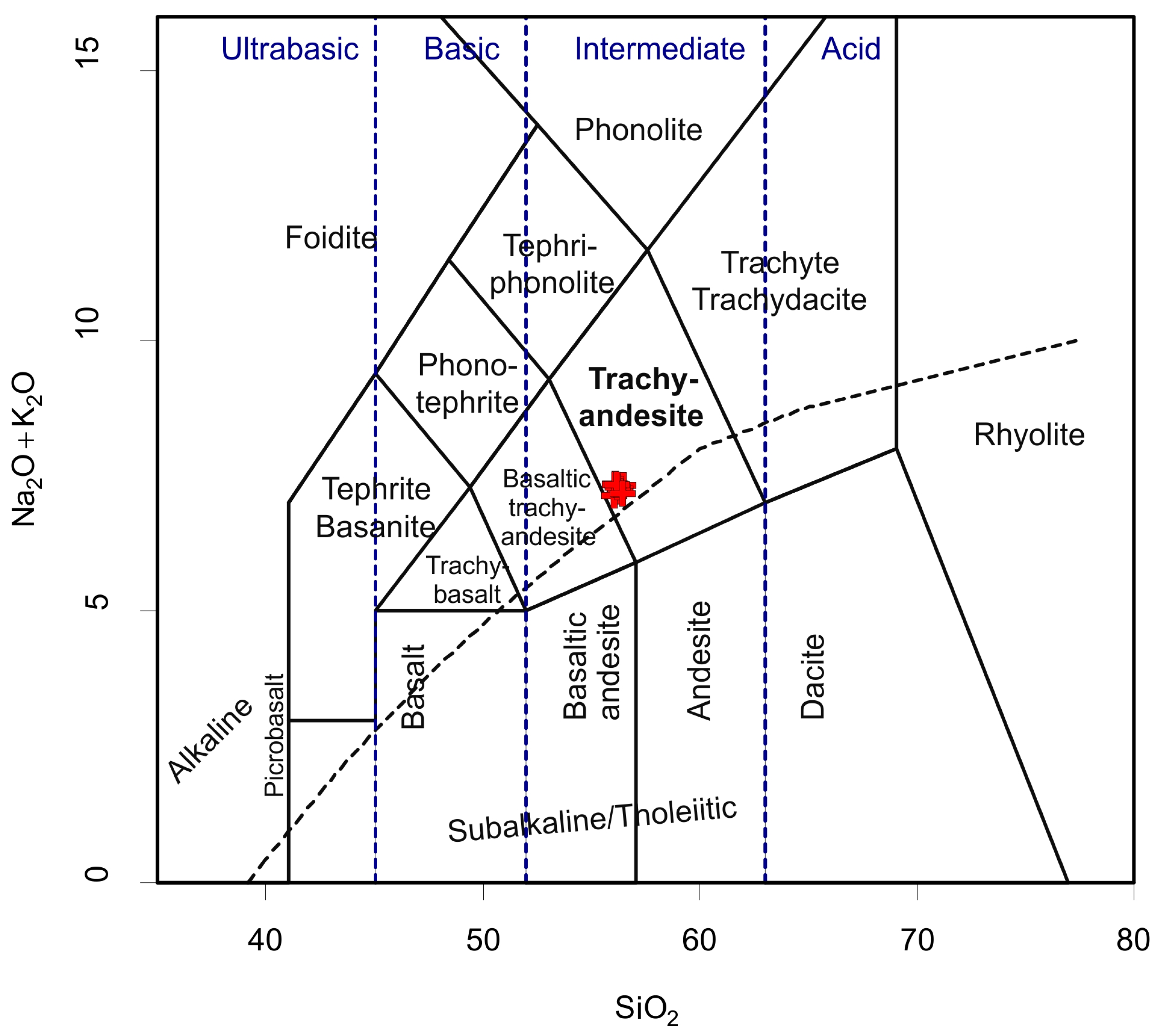
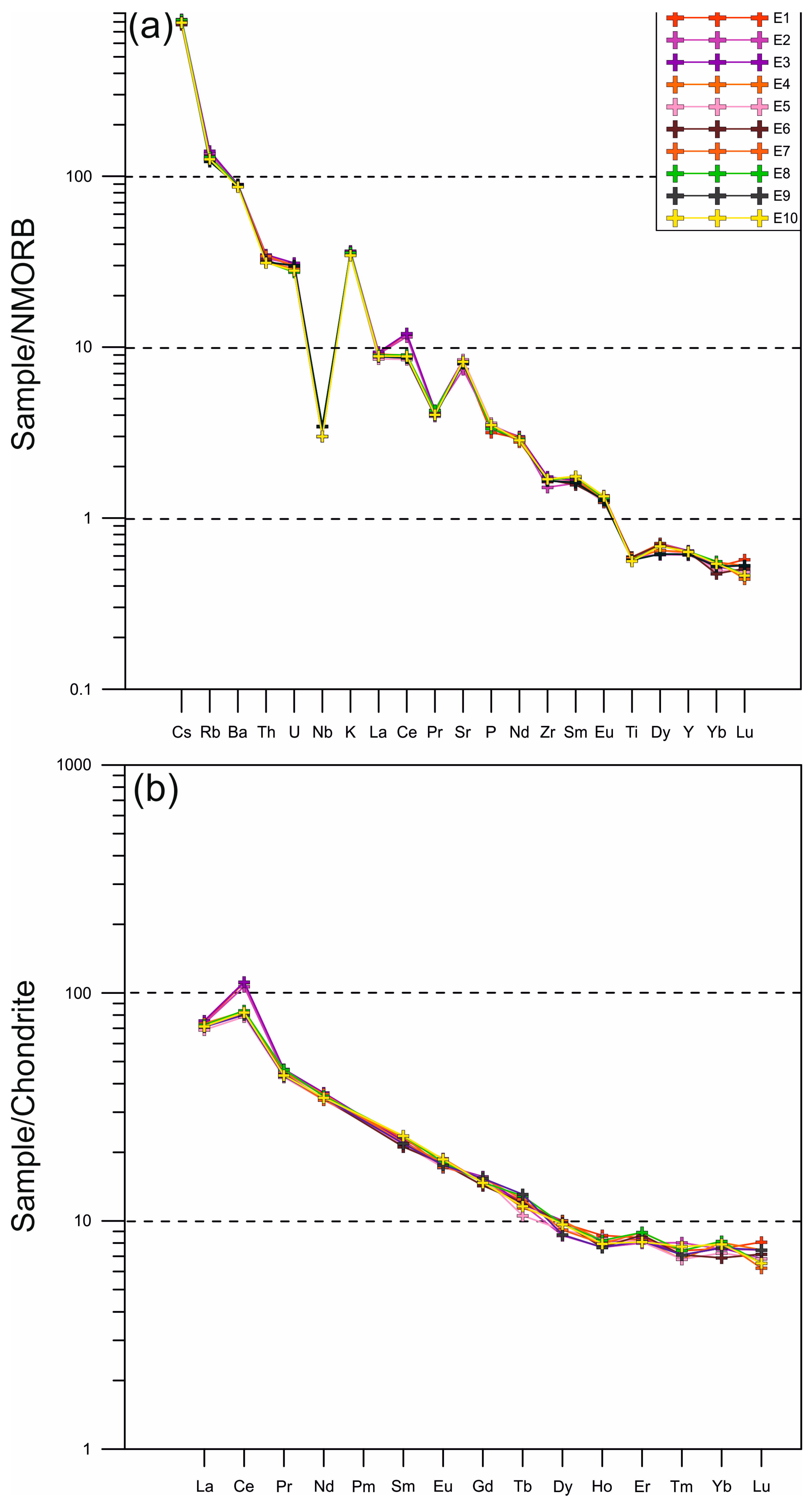
| Sample | E1 | E2 | E3 | E4 | E5 | E6 | E7 | E8 | E9 | E10 |
|---|---|---|---|---|---|---|---|---|---|---|
| Major oxides (wt %) | ||||||||||
| SiO2 | 54.76 | 54.73 | 54.69 | 54.71 | 54.42 | 54.56 | 54.53 | 54.42 | 54.57 | 54.68 |
| TiO2 | 0.74 | 0.75 | 0.73 | 0.75 | 0.74 | 0.75 | 0.74 | 0.72 | 0.72 | 0.71 |
| Al2O3 | 17.53 | 17.48 | 17.52 | 17.49 | 17.52 | 17.53 | 17.44 | 17.55 | 17.63 | 17.58 |
| Fe2O3 a | 7.21 | 7.52 | 7.42 | 7.54 | 7.58 | 7.44 | 7.42 | 7.38 | 7.46 | 7.32 |
| MnO | 0.18 | 0.18 | 0.18 | 0.18 | 0.18 | 0.18 | 0.18 | 0.18 | 0.18 | 0.18 |
| MgO | 2.86 | 2.81 | 2.80 | 2.83 | 2.95 | 2.94 | 2.89 | 2.92 | 2.93 | 2.91 |
| CaO | 6.32 | 6.37 | 6.34 | 6.31 | 6.35 | 6.36 | 6.37 | 6.39 | 6.17 | 6.23 |
| Na2O | 4.59 | 4.49 | 4.51 | 4.51 | 4.49 | 4.64 | 4.60 | 4.61 | 4.70 | 4.55 |
| K2O | 2.59 | 2.64 | 2.62 | 2.58 | 2.53 | 2.58 | 2.55 | 2.58 | 2.5 | 2.49 |
| P2O5 | 0.37 | 0.41 | 0.40 | 0.40 | 0.42 | 0.39 | 0.41 | 0.39 | 0.41 | 0.41 |
| LOI | 2.61 | 2.4 | 2.54 | 2.49 | 2.57 | 2.39 | 2.62 | 2.62 | 2.49 | 2.71 |
| Sum | 99.76 | 99.78 | 99.75 | 99.79 | 99.75 | 99.76 | 99.75 | 99.76 | 99.76 | 99.77 |
| Trace elements (ppm) | ||||||||||
| Sc | 14 | 16 | 15 | 16 | 17 | 15 | 17 | 15 | 15 | 17 |
| V | 139 | 140 | 139 | 140 | 147 | 143 | 147 | 143 | 146 | 145 |
| Co | 18 | 15 | 16 | 16 | 20 | 19 | 19 | 17 | 18 | 17 |
| Ni | 15 | 15 | 13 | 12 | 17 | 16 | 17 | 15 | 19 | 14 |
| Cu | 81 | 73 | 91 | 81 | 93 | 94 | 90 | 86 | 91 | 91 |
| Zn | 75 | 73 | 81 | 77 | 90 | 82 | 90 | 85 | 85 | 84 |
| Ga | 19.70 | 20.20 | 20.91 | 20.69 | 20.19 | 19.62 | 19.44 | 19.94 | 20.01 | 20.53 |
| Rb | 76.19 | 76.45 | 78.59 | 73.07 | 71.40 | 70.50 | 70.25 | 72.64 | 68.38 | 70.53 |
| Sr | 720 | 666 | 755 | 721 | 760 | 743 | 741 | 731 | 725 | 741 |
| Y | 17.54 | 17.03 | 18.01 | 17.77 | 17.22 | 17.74 | 17.67 | 17.86 | 17.17 | 17.77 |
| Zr | 121 | 112 | 129 | 123 | 126 | 124 | 124 | 123 | 122 | 125 |
| Nb | 8 | 7 | 8 | 7 | 8 | 7 | 8 | 8 | 8 | 7 |
| Cs | 5.54 | 5.51 | 5.80 | 5.56 | 5.68 | 5.40 | 5.62 | 5.76 | 5.59 | 5.55 |
| Ba | 565 | 560 | 564 | 556 | 552 | 550 | 561 | 559 | 557 | 546 |
| La | 22.93 | 22.78 | 23.40 | 22.76 | 21.34 | 22.24 | 22.31 | 22.46 | 21.99 | 22.13 |
| Ce | 89.69 | 86.22 | 90.20 | 67.16 | 63.51 | 65.92 | 65.73 | 67.62 | 64.79 | 66.35 |
| Pr | 5.50 | 5.46 | 5.64 | 5.47 | 5.21 | 5.37 | 5.29 | 5.62 | 5.26 | 5.31 |
| Nd | 21.32 | 21.54 | 21.89 | 21.62 | 20.38 | 20.69 | 20.36 | 21.18 | 20.83 | 20.83 |
| Sm | 4.43 | 4.20 | 4.36 | 4.29 | 4.23 | 4.12 | 4.55 | 4.58 | 4.26 | 4.61 |
| Eu | 1.38 | 1.28 | 1.29 | 1.33 | 1.26 | 1.31 | 1.27 | 1.33 | 1.29 | 1.37 |
| Gd | 3.82 | 3.89 | 4.05 | 3.94 | 4.02 | 3.70 | 3.99 | 3.82 | 3.98 | 3.81 |
| Tb | 0.58 | 0.56 | 0.56 | 0.54 | 0.50 | 0.57 | 0.59 | 0.61 | 0.62 | 0.55 |
| Dy | 3.15 | 2.78 | 3.23 | 3.22 | 2.94 | 3.17 | 2.94 | 3.11 | 2.80 | 3.11 |
| Ho | 0.62 | 0.55 | 0.58 | 0.59 | 0.60 | 0.55 | 0.57 | 0.59 | 0.55 | 0.57 |
| Er | 1.77 | 1.68 | 1.75 | 1.73 | 1.70 | 1.82 | 1.87 | 1.87 | 1.71 | 1.70 |
| Tm | 0.24 | 0.26 | 0.23 | 0.22 | 0.22 | 0.23 | 0.24 | 0.24 | 0.23 | 0.25 |
| Yb | 1.58 | 1.57 | 1.59 | 1.68 | 1.51 | 1.44 | 1.70 | 1.70 | 1.59 | 1.65 |
| Lu | 0.26 | 0.24 | 0.22 | 0.24 | 0.22 | 0.23 | 0.20 | 0.21 | 0.24 | 0.21 |
| Tl | 0.26 | 0.29 | 0.27 | 0.26 | 0.29 | 0.26 | 0.30 | 0.25 | 0.19 | 0.22 |
| Th | 4.12 | 3.96 | 4.17 | 4.10 | 3.78 | 3.90 | 3.76 | 3.77 | 3.78 | 3.74 |
| U | 1.39 | 1.44 | 1.46 | 1.41 | 1.37 | 1.31 | 1.35 | 1.29 | 1.41 | 1.32 |
| Mg# | 44.00 | 42.53 | 42.77 | 42.64 | 43.53 | 43.90 | 43.55 | 43.94 | 43.75 | 44.05 |
| Eu/Eu* | 1.03 | 0.97 | 0.94 | 0.99 | 0.93 | 1.03 | 0.91 | 0.97 | 0.96 | 1.00 |
| Sample | Rb a (ppm) | Sr (ppm) | 87Rb/86Sr | 87Sr/86Sr | ±2σm b | (87Sr/86Sr)i c,d,e | εSr(T) | Sm (ppm) | Nd (ppm) | 147Sm/144Nd | 143Nd/144Nd | ±2σm | (143Nd/144Nd)i | εNd(T) f | TDM (Ga) g |
|---|---|---|---|---|---|---|---|---|---|---|---|---|---|---|---|
| E1 | 76.19 | 720 | 0.306 | 0.706089 | 0.000007 | 0.706038 | 22.0 | 4.43 | 21.32 | 0.1256 | 0.512625 | 0.000005 | 0.512611 | −0.1 | 0.91 |
| E3 | 78.59 | 755 | 0.301 | 0.706087 | 0.000006 | 0.706037 | 22.0 | 4.36 | 21.89 | 0.1204 | 0.512628 | 0.000004 | 0.512615 | 0.0 | 0.85 |
| E5 | 71.4 | 760 | 0.272 | 0.706055 | 0.000005 | 0.706010 | 21.6 | 4.23 | 20.38 | 0.1255 | 0.512626 | 0.000004 | 0.512612 | −0.1 | 0.91 |
| E7 | 70.25 | 741 | 0.275 | 0.706098 | 0.000005 | 0.706052 | 22.2 | 4.55 | 20.36 | 0.1351 | 0.512622 | 0.000004 | 0.512607 | −0.2 | 1.02 |
| E9 | 68.38 | 725 | 0.273 | 0.706103 | 0.000006 | 0.706057 | 22.3 | 4.26 | 20.83 | 0.1236 | 0.512618 | 0.000004 | 0.512605 | −0.2 | 0.90 |
Disclaimer/Publisher’s Note: The statements, opinions and data contained in all publications are solely those of the individual author(s) and contributor(s) and not of MDPI and/or the editor(s). MDPI and/or the editor(s) disclaim responsibility for any injury to people or property resulting from any ideas, methods, instructions or products referred to in the content. |
© 2025 by the authors. Licensee MDPI, Basel, Switzerland. This article is an open access article distributed under the terms and conditions of the Creative Commons Attribution (CC BY) license (https://creativecommons.org/licenses/by/4.0/).
Share and Cite
Ertürk, M.A.; Yalçın, C. Petrogenesis and Tectonic Significance of Miocene Volcanic Rocks in the Ahlatlı–İspir–Erzurum Region, Türkiye. Minerals 2025, 15, 485. https://doi.org/10.3390/min15050485
Ertürk MA, Yalçın C. Petrogenesis and Tectonic Significance of Miocene Volcanic Rocks in the Ahlatlı–İspir–Erzurum Region, Türkiye. Minerals. 2025; 15(5):485. https://doi.org/10.3390/min15050485
Chicago/Turabian StyleErtürk, Mehmet Ali, and Cihan Yalçın. 2025. "Petrogenesis and Tectonic Significance of Miocene Volcanic Rocks in the Ahlatlı–İspir–Erzurum Region, Türkiye" Minerals 15, no. 5: 485. https://doi.org/10.3390/min15050485
APA StyleErtürk, M. A., & Yalçın, C. (2025). Petrogenesis and Tectonic Significance of Miocene Volcanic Rocks in the Ahlatlı–İspir–Erzurum Region, Türkiye. Minerals, 15(5), 485. https://doi.org/10.3390/min15050485







